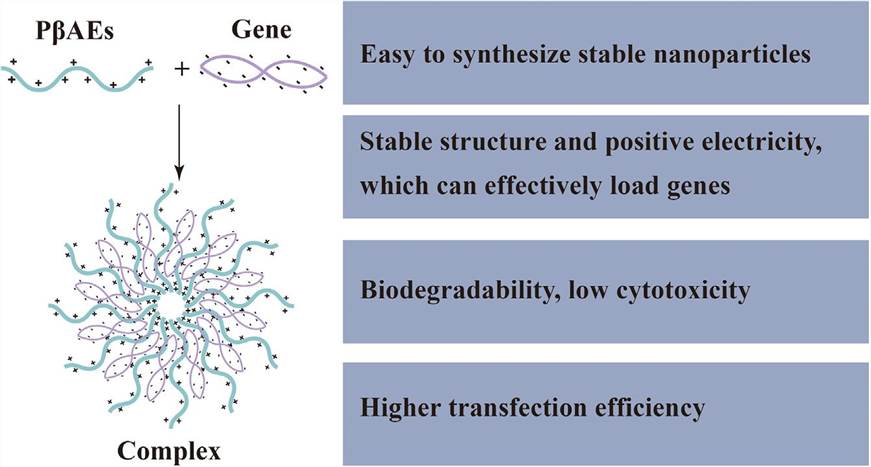PBAE-Based Nanocarrier Development
InquiryCD Formulation is at the forefront of engineering biomimetic non-viral nanocarriers for nucleic acid therapeutics. Through advanced macromolecular design and conjugation techniques, we functionalize poly (β-amino ester) (PBAE) nanoparticles with targeted ligands and stimuli-responsive elements to generate specialized formulations.
How Can PBAE Be Used in Nucleic Acid Delivery?
- PBAE polymers possess a structure composed of cationic amine groups and biodegradable ester links. This structure allows for electrostatic complexation with negatively charged nucleic acids, forming stable nanoparticles or complexes.
- PBAE polymers can be chemically modified to alter their physicochemical properties, such as their molecular weight, hydrophobicity, and charge density.
- PBAE-based delivery systems have shown high transfection efficiency, enabling effective delivery of nucleic acids to a wide range of cell types and tissues.
 Characteristics of PBAE suitable for nucleic acid delivery (Zhang J.; et al. 2023)
Characteristics of PBAE suitable for nucleic acid delivery (Zhang J.; et al. 2023)
What Can We Do for PBAE-Based Nanocarrier Development?
-
Monomer Selection
Choose suitable monomers that contain amine and ester functional groups, allowing for polymerization and subsequent branching of the PBAE structure.
-
Polymerization
Initiate the polymerization reaction by combining the selected monomers with a catalyst, typically a base or acid catalyst, under controlled conditions. This leads to the formation of polymer chains with repeating amine-ester units.
-
Chain Extension
Introduce a difunctional monomer or a small molecule with two reactive functional groups to extend the polymer chains, resulting in branched PBAE structures.
-
PBAE Purification
Purify the synthesized PBAE polymer to remove any unreacted monomers, catalysts, or impurities. This is typically achieved through solvent precipitation, dialysis, or column chromatography.
-
PBAE Modification
Modify the PBAE polymer by introducing specific functional groups or side chains to tailor its properties and targeting capabilities, for optimized nucleic acid delivery.
Types of PBAE-based Nanocarriers We Can Develop
Our expertise lies in developing PBAE-based nanoparticles for nucleic acid delivery, utilizing self-assembly techniques to formulate stable complexes that efficiently protect and deliver genetic material to target cells, enabling effective gene modulation.
Harnessing PBAE's unique properties, we engineered PBAE-based micelles for nucleic acid delivery. These micelles encapsulate genetic material within their hydrophobic core, enabling efficient cellular uptake and controlled release for enhanced therapeutic outcomes.
Our approach involves developing PBAE-based hydrogels for nucleic acid delivery. These cross-linked hydrogels provide a sustained release platform, allowing localized and controlled release of genetic material for targeted therapeutic interventions.
Our PBAE-Based Nanocarrier Analysis Services
- Physicochemical Characterization
We thoroughly analyze key attributes like particle size, distribution, surface charge, and morphology using techniques like DLS, TEM, and zeta potential measurements.
- Molecular Characterization
Techniques such as NMR, FTIR and GPC help characterize the polymer composition, purity and molecular weight.
TGA and DSC provide important insights into thermal stability and degradation behavior.
Sophisticated analytical methods like UV-Vis and fluorescence spectroscopy quantify the entrapment and association of nucleic acid/drug cargos.
We evaluate in vitro cargo release profiles under physiological conditions via dialysis or diffusion studies.
Tests like cytotoxicity, hemolysis, particle internalization assess biocompatibility and transfection efficiency.
We utilize in vivo optical or radio-labeling techniques to track nanoparticle trafficking.
Advantages of Our PBAE-Based Nanocarrier Development Services
- Through precision macromolecular engineering, our scientists intricately design PBAE polymers with tailored composition, molecular weight, and a hydrophobic-hydrophilic balance.
- Leveraging our breadth of nanotechnology expertise, we generate a spectrum of PBAE-based platforms including nanoparticles, micelles and coatings.
- We can assess biocompatibility, toxicity, biodistribution and therapeutic efficacy utilizing sophisticated in vitro and in vivo models.
- Our services cover a variety of applications, including gene therapy, mRNA vaccines, siRNA delivery, DNA vaccines, regenerative medicine, tissue engineering and personalized medicine.
At CD Formulation, we provide customized PBAE nanocarrier development solutions. Our past success in developing nucleic acid drug formulations demonstrates the advantages of our holistic approach. If you are seeking an experienced partner for the intelligent development of PBAE nanocarriers, please contact us!
References
- Zhang J.; et al. Poly (β-amino ester)s-based nanovehicles: Structural regulation and gene delivery. Mol Ther Nucleic Acids, 2023, available online.
- Karlsson J.; et al., Poly(beta-amino ester)s as gene delivery vehicles: challenges and opportunities. Expert Opin Drug Deliv. 2020, 17(10):1395-1410.
Related Services



 Characteristics of PBAE suitable for nucleic acid delivery (Zhang J.; et al. 2023)
Characteristics of PBAE suitable for nucleic acid delivery (Zhang J.; et al. 2023)